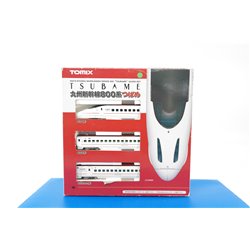Regardless of whether your locomotive uses analogue or DCC to operate, the principles of its motor will be the same,...
No products
Product successfully added to your shopping cart
There are 0 items in your cart. There is 1 item in your cart.
Search Tips
Christmas and New Year
Due to public holidays, orders will be next dispatched on Monday 29th.
If you select next day delivery at checkout, please note deliveries are not made on New Year's Day or Sundays.
The shop in Sandown is closed on Saturday 27th December and will reopen on Tuesday 30th December.
Tuesday 30th: 10am to 4.30pm - Wednesday 31st: 10am to 2.30pm - Thursday 1st: closed - Friday onwards: 10am to 4.30pm.
What is the Shinkansen?
The shinkansen, also known as the "bullet train," is Japan's high-speed rail network, renowned for its speed, precision and efficiency. Established in 1964, it was introduced in conjunction with the Tokyo Olympics, symbolising Japan’s technological prowess and post-war resurgence. The original line ran between Tokyo and Osaka, covering roughly 515 kilometres in a fraction of the time of conventional rail services. Since then, the network has expanded across Japan, connecting major cities and regions and providing an exemplary model for high-speed rail around the world.
The shinkansen operates at speeds that are impressive even by modern standards, with some trains reaching up to 320 km/h (200 mph). This speed allows passengers to travel from Tokyo to Osaka, a journey of about 400 miles, in roughly two and a half hours. Beyond speed, though, the shinkansen is also celebrated for its punctuality. With an average delay measured in seconds, it stands as one of the most reliable rail networks worldwide. This precision is achieved through a combination of advanced scheduling, regular maintenance and a dedicated workforce, making the shinkansen an attractive option for both business and leisure travellers.
One of the notable aspects of the shinkansen is the level of comfort and service it offers. Unlike some high-speed trains that prioritise efficiency over passenger experience, the shinkansen maintains high standards of cleanliness, spacious seating and onboard services such as trolley catering. The quiet atmosphere, reclining seats and ample legroom contribute to a relaxing journey, whether passengers are working, reading or simply admiring the Japanese countryside. For UK travellers, accustomed to trains with less focus on these aspects, the shinkansen provides a refreshing glimpse into Japan’s commitment to customer comfort.
The technology behind the shinkansen is both cutting-edge and constantly evolving. Japan’s engineers have developed various safety features, such as automatic braking systems and earthquake detection technologies. Given Japan's susceptibility to earthquakes, the rail network includes systems that can bring trains to a stop within seconds of seismic activity, minimising potential hazards. Additionally, the aerodynamic design of the train nose—distinctively elongated—reduces noise and improves energy efficiency, reflecting Japan’s emphasis on sustainability and environmental responsibility.
The shinkansen has also influenced rail systems globally, inspiring high-speed rail development in countries like France, China and even discussions in the UK. The speed, efficiency, and eco-friendliness of high-speed rail make it an appealing alternative to air travel for short and medium distances, especially in densely populated areas. In recent years, the UK has debated the expansion of its own high-speed network, such as the HS2 project, with comparisons often drawn to Japan’s successful implementation.
In addition to being a transportation system, the shinkansen is also a cultural icon within Japan. Featured in films, literature and art, it symbolises Japan’s dedication to progress, harmony with nature and attention to detail.
Click here to receive the tips weekly in your mailbox. You can unsubscribe at any time.








